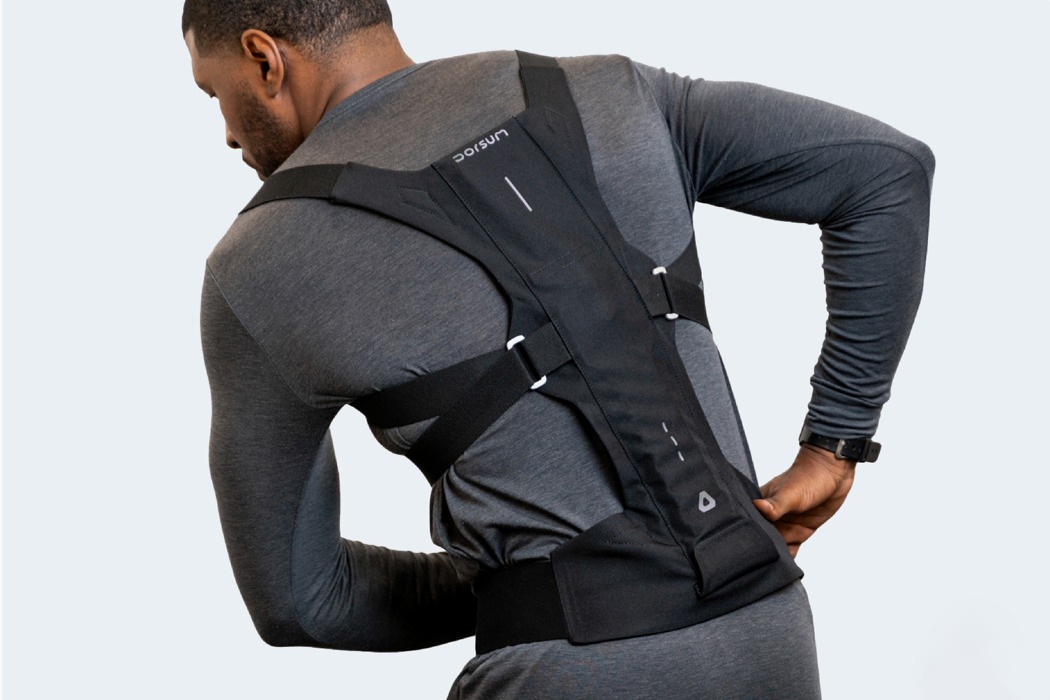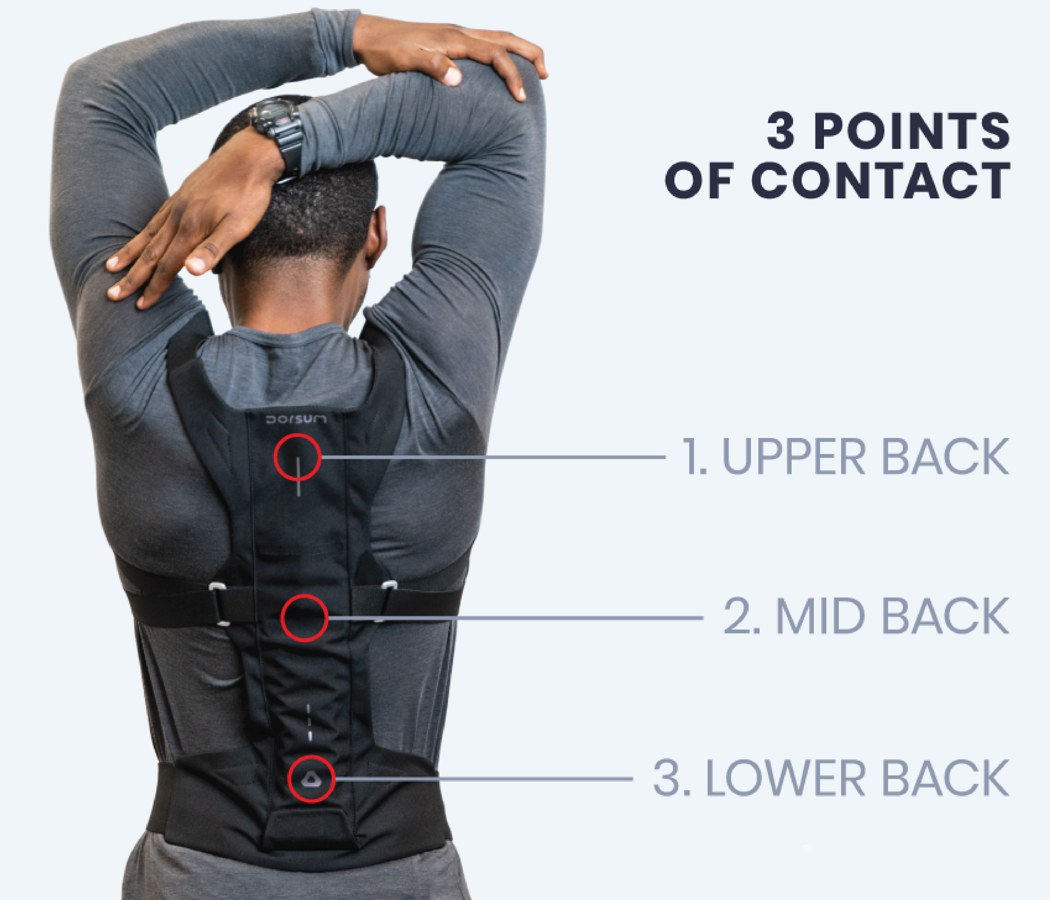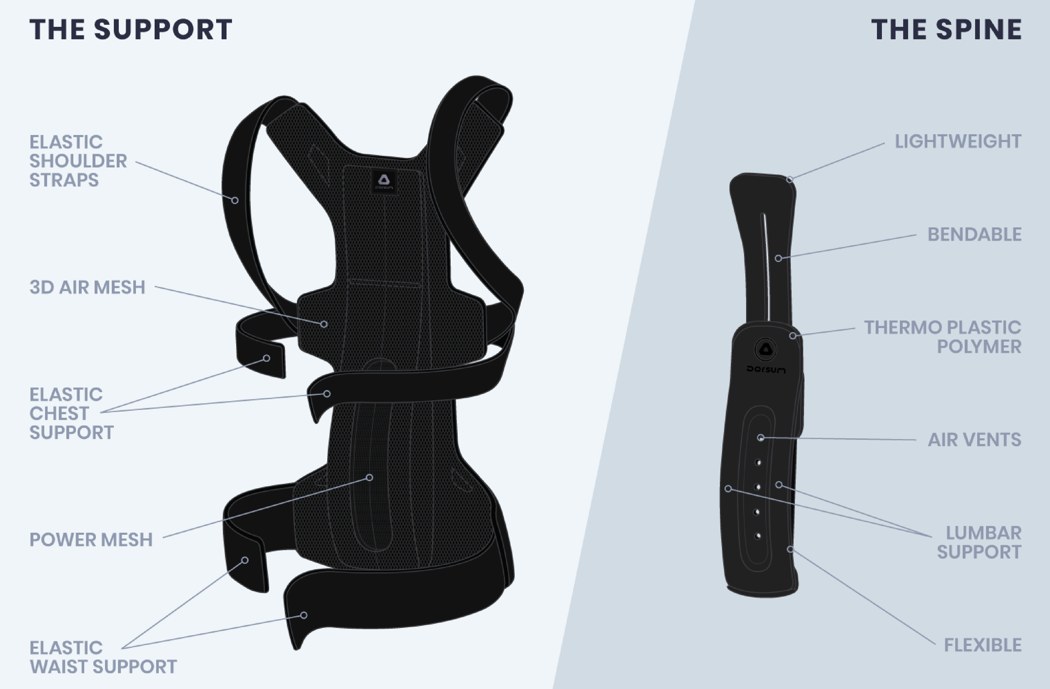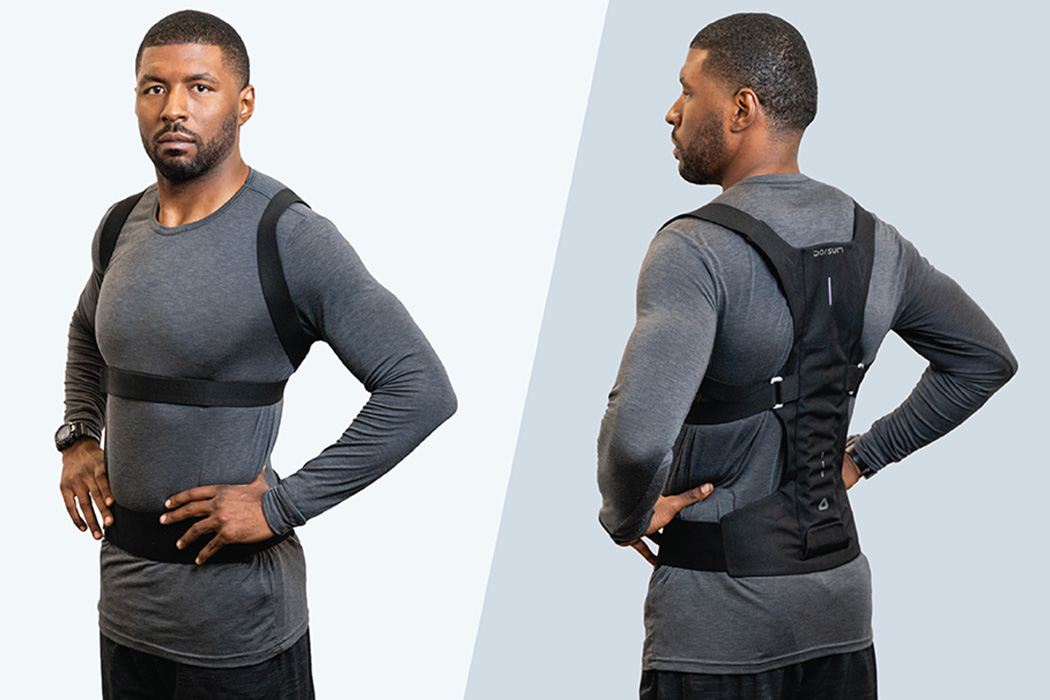YD Talks: How a design student and part-time fire-fighter designed a postural aid to prevent back pain - Yanko Design
https://www.kickstarter.com/projects/dorsumexospine/back-exospine-dorsumtechcom
Piddling did Leo Ochoa know, the work from his summer chore as a wild animals fire fighter many years ago, would requite his spine, of all things, dorsum problems. The risk of backache exists practically with every profession… whether it involves long hours on foot, heavy lifting, or even sitting on an uncomfortable chair at work for one-half a twenty-four hour period. For Leo, a brusk stint as a firefighter was enough for him to feel the fatigue on his spine. Once he realized that he wasn't the only one, and that almost everyone past a certain age feels spinal fatigue (almost people normalize information technology), Leo went on to develop the Dorsum Exospine.
The Back Exospine is a wearable that gives you a second-spine to help distribute the load and attempt, keeping your back safe and preventing injury or chronic aches. Molded from a thermoplastic polymer, the Dorsum Exospine is a combination of lightweight, supportive, and flexible materials. It integrates into a minimal shoulder-strap system and a waistband that allows you to secure it to your body, while a relatively discreet design allows you to clothing it under your clothes, just like whatever back-support belt.
Nosotros spoke with Leo Ochoa, founder of Dorsum and designer of the Dorsum Exospine about his product blueprint journey, and how necessity led him to invent a production that would keep to help people who face dorsum bug with a lifestyle that's either as well active or also sedentary. The Dorsum Exospine, according to Leo, is ideal for laborers, construction workers, package handlers, drivers, and stylish for even the office-going professional who faces the brunt of sitting for long hours on uncomfortable chairs.
Click Here to Buy At present: $150 $189 (xx% off). Hurry, less than 72 hours left!

Yanko Design: Hey Leo, nosotros're very happy to be doing this interview! Tell the states a fiddling near yourself and how you came to develop the Back Exospine.
Leo Ochoa: Likewise, and cheers for this opportunity to share how the Back Exospine came to be. I worked for three summers as a wildland firefighter to pay for my university expenses while I was studying design. Carrying equipment and heavy packs while doing repetitive work was no fun when my dorsum become fatigued and was in pain. But that job immune me to pay for part of my college.
What kept me coming back to do the physical work every summer, was the feeling that my work mattered and it made a difference in other people's lives. The best memories I have is when on the bulldoze back to our military camp, nosotros watched from our fire trucks the local people on their front porches waving their hands and holding signs.

Those signs read; Cheers for Saving Our Town. It was that feeling of making a deviation to an unabridged boondocks that motivated me to push button through the pain and come up back every summer. My dream position and so was to become a Hotshot firefighter, and exist office of an elite coiffure with qualifications to approach and fight fires from a much closer distance. Eventually, the risk of torso injury convinced me to take a different path.
The experience of fighting fires became a bigger part of me years afterward when studying product design at Art Center. We were given the assignment to design for future health and medical applications, and I chose to design for emergency response. Doing station visits and conducting interviews with n Los Angeles fire medics I started to notice a pattern emerge.

Every first responder I interviewed had a dorsum injury story, from the most common of a pulled musculus, to the most severe of a herniated disc. For some offset responders the injury had prevented them from returning to do the work they loved then much. Hearing how a elementary back injury crushed their dreams to salvage lives motivated me to help and do something through design.
It doesn't surprise me why the injuries go along happening, and part of the reason is the lack of preventative focused products in the market. I started prototyping means to support the trunk by creating a flexible vertical jump-like device to assistance keep the user upright and allow them to curve properly while doing their job. The result was reimagining the offset responder uniform and integrating the vertical spring in it. This was the get-go application of the Back Exospine into apparel.
YD: Did yous have any experience with back-braces before you fabricated the Dorsum Exospine? What were your thoughts on the electric current solutions?
LO: My experience with back-braces was from a designer's point of view, I wore several versions (non-injured) every bit a product report to empathize their use. My feel validates what everyone that has worn a dorsum-brace says, they are beefy, uncomfortable, restrict movement, and soon become warm and sweaty. You don't experience good wearing them. My thoughts are that they serve the function for what they were intended to be used for, post-injury and restrict the torso from movement. My blueprint perspective though, is that back-braces are antiquated and some are over-engineered. Their material is not breathable, use likewise much layering, and the blueprint is unattractive. They serve a purpose, but badly need a modern design and more innovation.
The Dorsum Exospine is different and the opposite of a back-brace. Information technology is designed to be flexible, and supportive while moving with the user and adapt to their everyday movements. It supports the upper, mid, and lower regions of the back, and all focused on reducing the risk of injury.
YD: There's this common theory that people with back problems shouldn't exist engaging in any activeness that causes them strain. What prompted you to design a product that goes against this theory that'southward so ingrained within everyone'due south minds?
LO: In design reviews with our medical experts, I learned that theory is outdated in many ways and needs clarification. There is a spectrum of back problems, from the most common affecting the muscles, to the most severe, affecting the joints and discs. It all depends on the severity of the injury of course. If the skeletal or spinal construction is afflicted, the all-time solution is to foreclose movement until the bones are correctly aligned.
For common strain from overuse of the muscles effectually the spine, as long every bit all vertebrae are correctly aligned, the best solution for the body is to continue existence active. When the body remains active, more claret which carries oxygen is delivered to the injured area, and waste is removed for consistent recovery. It is healthy to have blood pumping through your spine, and proper posture to appoint your core muscles, even while sitting.

The Back Exospine is non a brace and is designed to exist worn to keep your spine aligned while doing activities requiring repetitive movement. Inquiry shows when the spine is properly aligned, added weight to the torso is distributed evenly, and the risk of injury is significantly reduced. Although information technology is not a brace, it is a postural back up and encouragement of proper body mechanics equally an injury is healing, which is extremely of import to long term recovery.
YD: What age-bracket do you come across most Dorsum Exospine users falling under?
LO: We designed the Back Exospine for everyone, but nosotros see it being used primarily by the 25-45 age-bracket. This age group is developing the sensation that by investing in one's wellness early, i can prevent or delay an injury from happening. They sympathize the importance of maintaining an active life but are also the ones taking jobs that put their bodies at high risk of injury.
YD: Guide usa through the blueprint process of the Back Exospine. How did you lot arrive at the final form?
LO: Information technology has been a challenging process with a lot of learning at each stride of the way. User insights along the way showed u.s.a. we needed to adjust the functional requirements, changing the entire pattern three times. For the part of the spine I took inspiration from automotive leafage spring suspensions systems. Likewise pulling from my past experience in footwear and designing healthcare devices, I first created a lacing arrangement that would control the tension when bringing the Dorsum Exospine closer to the body.


With feedback from our focus groups of kickoff responders, we showtime designed a ballistic heavy duty utility vest to be worn over clothing. Then the preference was for the office to exist more than slim, flexible, and comfortable while sitting. This was our biggest challenge by far, and it took us many months until nosotros constitute a quantum. Finally, nosotros were able to design the product in a style that is adjustable and collapsible for maximum flexibility. This became a lighter version of the previous design but one that could be worn underneath workwear and closer to the trunk. The request for the product to be more breathable lead the states in the direction of the last version.
YD: What sort of prototypes did you make? What materials were you considering for the Back Exospine?
LO: For the outerwear utility belong nosotros used ballistic nylon fabric with power mesh for breathability with the Dorsum Exospine being made from 100% carbon cobweb. Nosotros could make the product cardboard, super lightweight, and very supportive. Using these advanced composites meant the Dorsum Exospine could be used nether extreme hot temperatures in case it needed to go into called-for structures to fight a fire. To add together flexibility nosotros baked a mix of ballistic nylon and carbon fiber more specific to firefighting.
Nosotros and so explored polycarbonate and jump steel to make a slimmer version of the Dorsum Exospine, that would fit into a lite belong/jersey style using compression fabrics. This created new challenges with adjustability and later on the winning design was the terminal version using elastic bands, ballistic nylon, and breathable mesh fabrics.
YD: Is the Dorsum Exospine curative/rehabilitative? Or does one wear it all their life?
LO: The Dorsum Exospine was designed and created to help reduce the hazard of the most common dorsum injuries, from muscular overuse and repetitive motion strains. It is a postural and ergonomic enhancer used to increment the functional motility of the wearer. Information technology supports the body by encouraging the wearer to movement properly throughout the repetitive movement the workday requests. It bolsters the body with three points of contact, supporting the upper thoracic, mid-thoracic, and lumbar spine regions. The wearer is effortlessly reminded to maintain natural spinal alignment and activate proper muscle groups while lifting and performing repetitive movements. When proper postural and ergonomic technique is maintained, injury is significantly less likely to occur.

The Dorsum Exospine back support is focused on prevention rather than rehabilitation. Wearing the device gives the user postural feedback to let them know when they're in and out of alignment. It gently guides the user into correct posture while too teaching the wearer what proper posture feels like. It is not intended for a person to clothing the production all their life, only while performing activities increasing the risk of body injury. Nosotros are finding from our testers that after wearing it, makes their bodies create muscle retention in their minds and they are much more than likely to maintain proper posture even when non wearing the device.
YD: Can the Dorsum Exospine exist worn with backpacks or while exercising or sleeping?
LO: Absolutely, past wearing the Dorsum Exospine with a haversack you feel more supported, the weight of the pack is evenly distributed along your unabridged back activating more the function of this Postural Assist. You lot can also wear the Dorsum Exospine while working out, especially in activities requiring you to maintain a straight back and hold that posture position for long periods of time. Using information technology while exercising has get a big request from or customers. Wearing it while sleeping is only functional if y'all sleep face, so yous can apply the weight of your trunk through your dorsum directly on the dorsum supporter. This volition continue your lumbar curve supported the entire fourth dimension you sleep.
YD: What sort of feedback are yous getting on the Dorsum Exospine? Are there whatever useful suggestions from the users?
LO: We've been getting keen feedback and the top 2 suggestions and requests have been, 1 – to brand the Dorsum Exospine more specific to exercising and weightlifting, and 2 – integration of the Dorsum Exospine with torso armor.
YD: I believe the Back Exospine is just one of the products under Dorsum's company line. What else are y'all working on?
LO: Without revealing too much, I can say we take continued working on a more than advanced, heavy duty version that requires more than development time, information technology's on our innovation track. Only that's non to say the suggestions from our users won't make it into our product line and to the market place sooner.
Click Here to Buy Now: $150 $189 (xx% off). Bustle, less than 72 hours left!
Source: https://www.yankodesign.com/2019/12/17/yd-talks-how-a-design-student-and-part-time-fire-fighter-designed-a-postural-aid-to-prevent-back-pain/
0 Response to "YD Talks: How a design student and part-time fire-fighter designed a postural aid to prevent back pain - Yanko Design"
Post a Comment